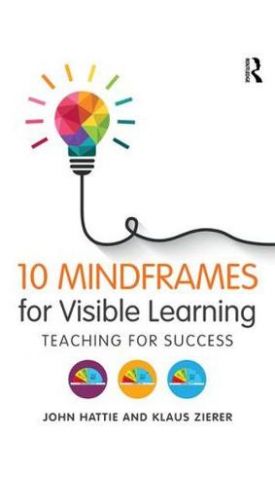אנו משתמשים ב-Cookies כדי לשפר את החוויה שלך. כדי לקיים ההנחיה החדשה של e-Privacy, עלינו לבקש את הסכמתך להגדיר את ה-Cookies. קבלת מידע נוסף.
145.00 ₪
10 Mindframes for Visible Learning: Teaching for Success
145.00 ₪
ISBN13
9781138635524
יצא לאור ב
London
עמודים
180
פורמט
Paperback / softback
תאריך יציאה לאור
12 בדצמ׳ 2017
The original Visible Learning research concluded that one of the most important influencers of student achievement is how teachers think about learning and their own role. In Ten Mindframes for Visible Learning, John Hattie and Klaus Zierer define the ten behaviors or mindframes that teachers need to adopt in order to maximize student success. These include:
thinking of and evaluating your impact on students' learning;
the importance of assessment and feedback for teachers;
working collaboratively and the sense of community;
the notion that learning needs to be challenging;
engaging in dialogue and the correct balance between talking and listening;
conveying the success criteria to learners;
building positive relationships.
These powerful mindframes, which should underpin every action in schools, are founded on the principle that teachers are evaluators, change agents, learning experts, and seekers of feedback who are constantly engaged with dialogue and challenge.
This practical guide, which includes questionnaires, scenarios, checklists, and exercises, will show any school exactly how to implement Hattie's mindframes to maximize success.
| עמודים | 180 |
|---|---|
| פורמט | Paperback / softback |
| ISBN10 | 1138635529 |
| יצא לאור ב | London |
| תאריך יציאה לאור | 12 בדצמ׳ 2017 |
| תוכן עניינים | List of Figures Preface. How we think about the impact of what we do is more important than what we do Chapter 1. I am an evaluator of my impact on student learning Chapter 2. I see assessment as informing my impact and next steps Chapter 3. I collaborate with my peers and my students about my conceptions of progress and my impact Chapter 4. I am a change agent and believe all students can improve Chapter 5. I strive for challenge and not merely `doing your best' Chapter 6. I give and help students understand feedback and I interpret and act on feedback given to me Chapter 7. I engage as much in dialgoue as monologue Chapter 8. I explicitly inform students what successful impact looks like from the outset Chapter 9. I build relationships and trust so that learning can occur in a place where it is safe to make mistakes and learn from others Chapter 10. I focus on the learning and the language of learning Chapter 11. Visible Learning: a vision Bibliography |



Login and Registration Form